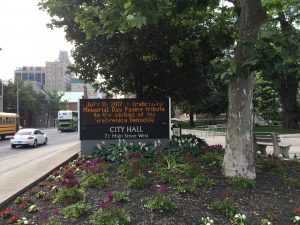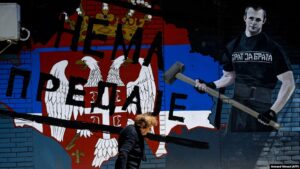Press Release of the Genocide Research Institute, Canada
Mayor Hamilton announced July 11th The Day of Remembrance of Victims of Genocide against Bosniaks of Srebrenica
On the occasion of the 22nd anniversary of the genocide in the “UN protected area” Srebrenica, Mayor of Hamilton, Fred Eisenberger, on the proposal of Councillor Maria Pearson, declared July 11th the Day of Remembrance for the Victims of Genocide against the Bosniaks of Srebrenica. On the electronic panel in front of the building of the Assembly is written:
July 11. Srebrenica Memorial Day in Hamilton.
Paying tribute to the victims of the Srebrenica Genocide.
At the end of the 20th century in the heart of Europe, Serbia and Montenegro and their authorities – pseudo-state creation Republika Srpska committed in a small Balkan state – the Republic of Bosnia and Herzegovina, the crime of genocide against Bosniacs, members of a national, ethnic, and religious group as such. This crime of genocide, by its extent, intensity, intentions, modus operandi, objectives, and consequences, was particularly noticeable in Srebrenica, the UN Safe Area in July 1995, when the Serbian aggressor (Federal Republic of Yugoslavia – Serbia and Montenegro) along with their (Serb) collaborators and fifth-column from the Republic of Bosnia and Herzegovina and the accomplices from the dominant part of the international community, in and around UN Safe Area Srebrenica, during only one week in July 1995, captured, killed and buried in mass graves thousands of Bosniacs; buried alive hundreds of them; mutilated and slaughtered men, women, and boys; killed children before their mothers; forced a grandfather to eat the liver of his grandson; raped women and girls; expelled around 30,000 people, mainly women and children, presented the scenes from the Dante’s Hell. There are ample pieces of evidence attesting to these “scenes of unimaginable savagery”, including mass graves – primary, secondary, and tertiary. According to the ICTY, these are “indeed the scenes from hell, written on the darkest pages of human civilization”.
The genocide has to be studied and scientifically researched, both for the scientific and social reasons. Education in the process of teaching is an essential component of socialization, in which certain knowledge, values, norms, customs, and cultures are acquired, all serving the function of memory and permanent remembrance. This is a permanent obligation of the present generations towards all the victims of the Holocaust and genocide, including the victims of the Srebrenica genocide.
It is the obligation of all of us to detect and identify the human, social, and scientific truth about genocide and other forms of crimes against humanity and international law, being an important condition for achieving the justice and rights, without which it is not possible to get the reconciliation and build the common future in Bosnia and Herzegovina.
The Government of Canada has continuously and in a specific manner displayed its sensibility and piety towards the genocide victims in Bosnia and Herzegovina, particularly Srebrenica victims. The proof is also this monument to the Srebrenica genocide victims here in Windsor, which will permanently remind all of us surviving genocide victims, witnesses, and successors, including the free democratic society in Canada with its developed individual and societal consciousness about the worst evil committed against the innocent, barehanded, and helpless human beings, just because of their national, ethnic, racial, and religious background.
We express the sincerest and deepest human gratitude to Canada for: recognizing Bosnian language as a World heritage language; using Bosniac ethnic in all the statistical and other Canadian data; adopting two Resolutions on genocide in Srebrenica and in the Republic of Bosnia and Herzegovina in the Canadian Parliament; the towns of Hamilton and Windsor that paid tribute to the genocide victims in Srebrenica; celebrating the 31st May in Canada as the World Day of White Ribbons; the request of the Canadian Government to implement the Bosnia and Herzegovina Constitutional Court decision on non‑constitutionality of 9 January; having the permanent exhibition on the genocide in Srebrenica and Bosnia and Herzegovina in the Canadian Museum for Human Rights; recognizing the relevance of the Independence Day of Bosnia and Herzegovina and the Statehood Day of Bosnia and Herzegovina, as well as opening of the monument in Windsor.
Studying scientifically genocide and other forms of crimes against humanity and international law does not include and does not require only the knowledge of the science of genocide, methods of genocide research, but it is rather the matter of bravery, principle attitude, human dignity, and consistency in disclosing the human, social, and scientific, truth and its presentation to the scientific and general public, by which we influence the individual and social awareness related to the development of the positive system of social values, and label evil, and at the same time create conditions for its social, legal, and moral sanctioning. In this process of registration of experience (indirect and direct) through the remembrance, comparison, and valuing, it is important, among other things, to affirm and develop positive and good in fighting this worst social evil, as genocide is.
Professor Emir Ramic
Chairman of the Institute for Research of Genocide Canada



